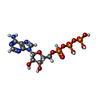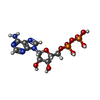+ Open data
Open data
- Basic information
Basic information
| Entry |  | |||||||||
|---|---|---|---|---|---|---|---|---|---|---|
| Title | Nub1/Fat10-processing human 26S proteasome | |||||||||
 Map data Map data | ||||||||||
 Sample Sample |
| |||||||||
 Keywords Keywords | 26S Proteasome / Nub1 / Fat10 / MOTOR PROTEIN / HYDROLASE-PROTEIN BINDING complex | |||||||||
| Function / homology |  Function and homology information Function and homology informationregulation of ubiquitin-dependent protein catabolic process / Lewy body / Impaired BRCA2 translocation to the nucleus / Impaired BRCA2 binding to SEM1 (DSS1) / thyrotropin-releasing hormone receptor binding / nuclear proteasome complex / host-mediated perturbation of viral transcription / positive regulation of inclusion body assembly / Hydrolases; Acting on peptide bonds (peptidases); Omega peptidases / integrator complex ...regulation of ubiquitin-dependent protein catabolic process / Lewy body / Impaired BRCA2 translocation to the nucleus / Impaired BRCA2 binding to SEM1 (DSS1) / thyrotropin-releasing hormone receptor binding / nuclear proteasome complex / host-mediated perturbation of viral transcription / positive regulation of inclusion body assembly / Hydrolases; Acting on peptide bonds (peptidases); Omega peptidases / integrator complex / proteasome accessory complex / meiosis I / purine ribonucleoside triphosphate binding / proteasome regulatory particle / cytosolic proteasome complex / positive regulation of proteasomal protein catabolic process / proteasome-activating activity / proteasome regulatory particle, lid subcomplex / proteasome regulatory particle, base subcomplex / protein K63-linked deubiquitination / metal-dependent deubiquitinase activity / negative regulation of programmed cell death / Regulation of ornithine decarboxylase (ODC) / Proteasome assembly / Cross-presentation of soluble exogenous antigens (endosomes) / proteasome core complex / Homologous DNA Pairing and Strand Exchange / Defective homologous recombination repair (HRR) due to BRCA1 loss of function / Defective HDR through Homologous Recombination Repair (HRR) due to PALB2 loss of BRCA1 binding function / Defective HDR through Homologous Recombination Repair (HRR) due to PALB2 loss of BRCA2/RAD51/RAD51C binding function / Resolution of D-loop Structures through Synthesis-Dependent Strand Annealing (SDSA) / Somitogenesis / K63-linked deubiquitinase activity / Resolution of D-loop Structures through Holliday Junction Intermediates / Impaired BRCA2 binding to RAD51 / proteasome binding / transcription factor binding / regulation of protein catabolic process / myofibril / response to tumor necrosis factor / proteasome storage granule / Presynaptic phase of homologous DNA pairing and strand exchange / general transcription initiation factor binding / polyubiquitin modification-dependent protein binding / positive regulation of RNA polymerase II transcription preinitiation complex assembly / protein deubiquitination / blastocyst development / immune system process / NF-kappaB binding / proteasome endopeptidase complex / response to type II interferon / proteasome core complex, beta-subunit complex / endopeptidase activator activity / proteasome assembly / threonine-type endopeptidase activity / mRNA export from nucleus / proteasome core complex, alpha-subunit complex / proteasomal protein catabolic process / SARS-CoV-1 targets host intracellular signalling and regulatory pathways / enzyme regulator activity / regulation of proteasomal protein catabolic process / ERAD pathway / inclusion body / proteasome complex / proteolysis involved in protein catabolic process / TBP-class protein binding / sarcomere / Regulation of activated PAK-2p34 by proteasome mediated degradation / Autodegradation of Cdh1 by Cdh1:APC/C / APC/C:Cdc20 mediated degradation of Securin / N-glycan trimming in the ER and Calnexin/Calreticulin cycle / stem cell differentiation / Asymmetric localization of PCP proteins / Ubiquitin-dependent degradation of Cyclin D / SCF-beta-TrCP mediated degradation of Emi1 / NIK-->noncanonical NF-kB signaling / TNFR2 non-canonical NF-kB pathway / AUF1 (hnRNP D0) binds and destabilizes mRNA / Vpu mediated degradation of CD4 / Assembly of the pre-replicative complex / Ubiquitin-Mediated Degradation of Phosphorylated Cdc25A / negative regulation of inflammatory response to antigenic stimulus / Degradation of DVL / Dectin-1 mediated noncanonical NF-kB signaling / Cdc20:Phospho-APC/C mediated degradation of Cyclin A / P-body / lipopolysaccharide binding / Degradation of AXIN / Hh mutants are degraded by ERAD / Activation of NF-kappaB in B cells / Degradation of GLI1 by the proteasome / G2/M Checkpoints / Hedgehog ligand biogenesis / Defective CFTR causes cystic fibrosis / Autodegradation of the E3 ubiquitin ligase COP1 / GSK3B and BTRC:CUL1-mediated-degradation of NFE2L2 / Regulation of RUNX3 expression and activity / Negative regulation of NOTCH4 signaling / Hedgehog 'on' state / double-strand break repair via homologous recombination Similarity search - Function | |||||||||
| Biological species |  Homo sapiens (human) Homo sapiens (human) | |||||||||
| Method | single particle reconstruction / cryo EM / Resolution: 3.1 Å | |||||||||
 Authors Authors | Arkinson C / Gee CL / Martin A | |||||||||
| Funding support |  United States, 1 items United States, 1 items
| |||||||||
 Citation Citation |  Journal: Nat Struct Mol Biol / Year: 2025 Journal: Nat Struct Mol Biol / Year: 2025Title: NUB1 traps unfolded FAT10 for ubiquitin-independent degradation by the 26S proteasome. Authors: Connor Arkinson / Ken C Dong / Christine L Gee / Shawn M Costello / Aimee Chi Soe / Greg L Hura / Susan Marqusee / Andreas Martin /  Abstract: The ubiquitin-like modifier FAT10 targets hundreds of proteins in the mammalian immune system to the 26S proteasome for degradation. This degradation pathway requires the cofactor NUB1, yet the ...The ubiquitin-like modifier FAT10 targets hundreds of proteins in the mammalian immune system to the 26S proteasome for degradation. This degradation pathway requires the cofactor NUB1, yet the underlying mechanisms remain unknown. Here, we reconstituted a minimal in vitro system with human components and revealed that NUB1 uses the intrinsic instability of FAT10 to trap its N-terminal ubiquitin-like domain in an unfolded state and deliver it to the 26S proteasome for engagement, allowing the degradation of FAT10-ylated substrates in a ubiquitin-independent and p97-independent manner. Using hydrogen-deuterium exchange, structural modeling and site-directed mutagenesis, we identified the formation of an intricate complex with FAT10 that activates NUB1 for docking to the 26S proteasome, and our cryo-EM studies visualized the highly dynamic NUB1 complex bound to the proteasomal Rpn1 subunit during FAT10 delivery and the early stages of ATP-dependent degradation. These findings identified a previously unknown mode of cofactor-mediated, ubiquitin-independent substrate delivery to the 26S proteasome that relies on trapping partially unfolded states for engagement by the proteasomal ATPase motor. | |||||||||
| History |
|
- Structure visualization
Structure visualization
| Supplemental images |
|---|
- Downloads & links
Downloads & links
-EMDB archive
| Map data |  emd_42507.map.gz emd_42507.map.gz | 42.4 MB |  EMDB map data format EMDB map data format | |
|---|---|---|---|---|
| Header (meta data) |  emd-42507-v30.xml emd-42507-v30.xml emd-42507.xml emd-42507.xml | 53.2 KB 53.2 KB | Display Display |  EMDB header EMDB header |
| FSC (resolution estimation) |  emd_42507_fsc.xml emd_42507_fsc.xml | 9.2 KB | Display |  FSC data file FSC data file |
| Images |  emd_42507.png emd_42507.png | 100.9 KB | ||
| Filedesc metadata |  emd-42507.cif.gz emd-42507.cif.gz | 14.5 KB | ||
| Others |  emd_42507_half_map_1.map.gz emd_42507_half_map_1.map.gz emd_42507_half_map_2.map.gz emd_42507_half_map_2.map.gz | 77.6 MB 77.6 MB | ||
| Archive directory |  http://ftp.pdbj.org/pub/emdb/structures/EMD-42507 http://ftp.pdbj.org/pub/emdb/structures/EMD-42507 ftp://ftp.pdbj.org/pub/emdb/structures/EMD-42507 ftp://ftp.pdbj.org/pub/emdb/structures/EMD-42507 | HTTPS FTP |
-Related structure data
| Related structure data |  8uscMC  8usbC  8usdC M: atomic model generated by this map C: citing same article ( |
|---|---|
| Similar structure data | Similarity search - Function & homology  F&H Search F&H Search |
- Links
Links
| EMDB pages |  EMDB (EBI/PDBe) / EMDB (EBI/PDBe) /  EMDataResource EMDataResource |
|---|---|
| Related items in Molecule of the Month |
- Map
Map
| File |  Download / File: emd_42507.map.gz / Format: CCP4 / Size: 83.7 MB / Type: IMAGE STORED AS FLOATING POINT NUMBER (4 BYTES) Download / File: emd_42507.map.gz / Format: CCP4 / Size: 83.7 MB / Type: IMAGE STORED AS FLOATING POINT NUMBER (4 BYTES) | ||||||||||||||||||||||||||||||||||||
|---|---|---|---|---|---|---|---|---|---|---|---|---|---|---|---|---|---|---|---|---|---|---|---|---|---|---|---|---|---|---|---|---|---|---|---|---|---|
| Projections & slices | Image control
Images are generated by Spider. | ||||||||||||||||||||||||||||||||||||
| Voxel size | X=Y=Z: 1.048 Å | ||||||||||||||||||||||||||||||||||||
| Density |
| ||||||||||||||||||||||||||||||||||||
| Symmetry | Space group: 1 | ||||||||||||||||||||||||||||||||||||
| Details | EMDB XML:
|
-Supplemental data
-Half map: #2
| File | emd_42507_half_map_1.map | ||||||||||||
|---|---|---|---|---|---|---|---|---|---|---|---|---|---|
| Projections & Slices |
| ||||||||||||
| Density Histograms |
-Half map: #1
| File | emd_42507_half_map_2.map | ||||||||||||
|---|---|---|---|---|---|---|---|---|---|---|---|---|---|
| Projections & Slices |
| ||||||||||||
| Density Histograms |
- Sample components
Sample components
+Entire : Human 26S proteasome complexed with Nub1 and Fat 10
+Supramolecule #1: Human 26S proteasome complexed with Nub1 and Fat 10
+Macromolecule #1: Proteasome subunit alpha type-2
+Macromolecule #2: 26S proteasome non-ATPase regulatory subunit 6
+Macromolecule #3: 26S proteasome non-ATPase regulatory subunit 2
+Macromolecule #4: 26S proteasome non-ATPase regulatory subunit 11
+Macromolecule #5: 26S proteasome non-ATPase regulatory subunit 1
+Macromolecule #6: 26S proteasome non-ATPase regulatory subunit 7
+Macromolecule #7: 26S proteasome non-ATPase regulatory subunit 13
+Macromolecule #8: 26S proteasome non-ATPase regulatory subunit 4
+Macromolecule #9: 26S proteasome regulatory subunit 7
+Macromolecule #10: 26S proteasome regulatory subunit 4
+Macromolecule #11: 26S protease regulatory subunit 8
+Macromolecule #12: 26S proteasome regulatory subunit 6B
+Macromolecule #13: 26S protease regulatory subunit 10B
+Macromolecule #14: 26S proteasome regulatory subunit 6A
+Macromolecule #15: substrate peptide
+Macromolecule #16: Proteasome subunit alpha type-6
+Macromolecule #17: Proteasome subunit alpha type-4
+Macromolecule #18: Proteasome subunit alpha type-7
+Macromolecule #19: Proteasome subunit alpha type-5
+Macromolecule #20: Proteasome subunit alpha type-1
+Macromolecule #21: Proteasome subunit alpha type-3
+Macromolecule #22: Proteasome subunit beta type-7
+Macromolecule #23: 26S proteasome complex subunit SEM1
+Macromolecule #24: 26S proteasome non-ATPase regulatory subunit 8
+Macromolecule #25: 26S proteasome non-ATPase regulatory subunit 12
+Macromolecule #26: Isoform 2 of NEDD8 ultimate buster 1
+Macromolecule #27: 26S proteasome non-ATPase regulatory subunit 3
+Macromolecule #28: 26S proteasome non-ATPase regulatory subunit 14
+Macromolecule #29: MAGNESIUM ION
+Macromolecule #30: ADENOSINE-5'-TRIPHOSPHATE
+Macromolecule #31: ADENOSINE-5'-DIPHOSPHATE
+Macromolecule #32: ZINC ION
-Experimental details
-Structure determination
| Method | cryo EM |
|---|---|
 Processing Processing | single particle reconstruction |
| Aggregation state | particle |
- Sample preparation
Sample preparation
| Buffer | pH: 7.4 Details: 30 mM HEPES pH7.4, 25 mM NaCl, 25 mM KCl, 3% (v/v) glycerol, 5 mM MgCl2 2 mM ATP and 0.5 mM TCEP |
|---|---|
| Grid | Model: UltrAuFoil R2/2 / Material: GOLD / Mesh: 500 / Support film - Material: GOLD / Pretreatment - Type: GLOW DISCHARGE / Pretreatment - Time: 25 sec. / Details: 25 mA |
| Vitrification | Cryogen name: ETHANE / Chamber humidity: 100 % / Chamber temperature: 298 K / Instrument: FEI VITROBOT MARK IV |
- Electron microscopy
Electron microscopy
| Microscope | FEI TITAN KRIOS |
|---|---|
| Image recording | Film or detector model: GATAN K3 (6k x 4k) / Average electron dose: 50.0 e/Å2 |
| Electron beam | Acceleration voltage: 300 kV / Electron source:  FIELD EMISSION GUN FIELD EMISSION GUN |
| Electron optics | Illumination mode: FLOOD BEAM / Imaging mode: BRIGHT FIELD / Nominal defocus max: 1.7 µm / Nominal defocus min: 0.5 µm |
| Sample stage | Specimen holder model: FEI TITAN KRIOS AUTOGRID HOLDER / Cooling holder cryogen: NITROGEN |
| Experimental equipment |  Model: Titan Krios / Image courtesy: FEI Company |
 Movie
Movie Controller
Controller



















 Z (Sec.)
Z (Sec.) Y (Row.)
Y (Row.) X (Col.)
X (Col.)








































